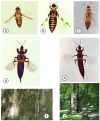Overwintering of Thrips (Thysanoptera) Under the Bark of the Plane Tree (Platanus x hispanica Mill. ex Münchh.) in Southeastern Poland
- PMID: 39859673
- PMCID: PMC11765657
- DOI: 10.3390/insects16010092
Overwintering of Thrips (Thysanoptera) Under the Bark of the Plane Tree (Platanus x hispanica Mill. ex Münchh.) in Southeastern Poland
Abstract
The insect fauna overwintering under the bark of tree trunks is very rarely studied. Thrips (Thysanoptera) associated with the plane tree (Platanus x hispanica Mill. ex Münchh., syn. Platanus x acerifolia (Aiton) Willd.) have not been studied so far, especially those overwintering on the non-native tree in Poland. The study was carried out in March and April 2014 and 2015 and in February 2016 in 29 localities in southeastern Poland. The study sites were localized in urban and rural parks. Tree bark samples were taken from each trunk at a height of 1-2 m and collected in 4 L plastic bags (approximately 250 cm2). Thrips were sorted from the pieces of plane tree bark in the laboratory and preserved in 70% ethyl alcohol; the species were identified on microscopic slides. Fifteen species, nine from the suborder Terebrantia and six from the suborder Tubulifera, were identified. Ten species were dendrophilous, among which all Tubuliferan species were fungivorous. A total of 494 thrips individuals were collected, with 84% representing the suborder Terebrantia. The most abundant thrips species included Dendrothrips degeeri Uzel, Phlaeothrips coriaceus Haliday, Thrips major Uzel, and Dendrothrips ornatus (Jablonowski). D. degeeri, i.e., the most numerous species, was found in the highest number of sites (22), while six species were only found in one site each. Generalized Linear Model (GLM) and Nonmetric Multidimensional Scaling (NMDS) analysis showed that the species composition was strongly associated with environmental such factors as insolation, the trunk circumference, and the number of trunks where the species overwintered. Our research has shown that the bark of plane trees (Platanus x hispanica) provided a suitable habitat for thrips overwintering.
Keywords: London plane; biodiversity; overwintering; plane tree; thrips; tree bark.
Conflict of interest statement
The authors declare no conflicts of interest.
Figures




References
-
- ThripsWiki . Providing information on the World’s thrips (version 2022-10-07) In: Bánki O., Roskov Y., Döring M., Ower G., Hernández Robles D.R., Plata Corredor C.A., Stjernegaard Jeppesen T., Örn A., Vandepitte L., Pape T., et al., editors. Catalogue of Life. Catalogue of Life; Amsterdam, The Netherlands: 2024. version 2024-10-22. - DOI
-
- Kirk W.D.J. Feeding. In: Lewis T., editor. Thrips as Crop Pests. CAB International, University Press; Cambridge, UK: 1997. pp. 119–174.
-
- Mound L., Collins D., Hastings A. Thysanoptera Britannica et Hibernica. A Guide to British Thrips. Lucidcentral.org, Identic Pty Ltd.; Queensland, Australia: 2018. [(accessed on 20 October 2024)]. Available online: https://keys.lucidcentral.org/keys/v3/british_thrips/
-
- Moritz G. Structure, growth and development. In: Lewis T., editor. Thrips as Crop Pests. CAB International, University Press; Cambridge, UK: 1997. pp. 15–63.
-
- Lewis T., Navas E. Thysanopteran populations overwintering in hedge bottoms, grass litter and bark. Ann. Appl. Biol. 1962;50:299–311. doi: 10.1111/j.1744-7348.1962.tb06012.x. - DOI
LinkOut - more resources
Full Text Sources
Miscellaneous

